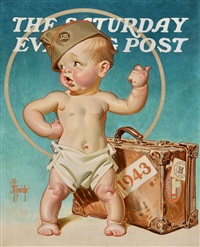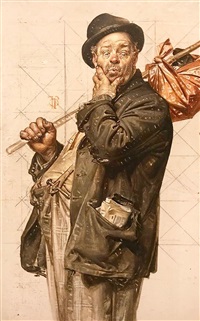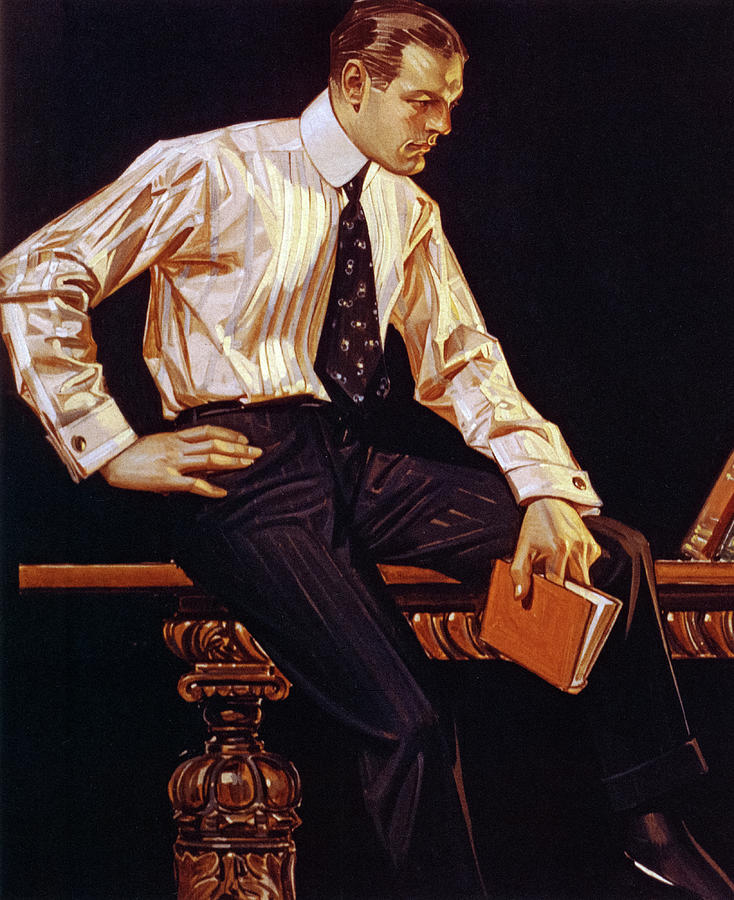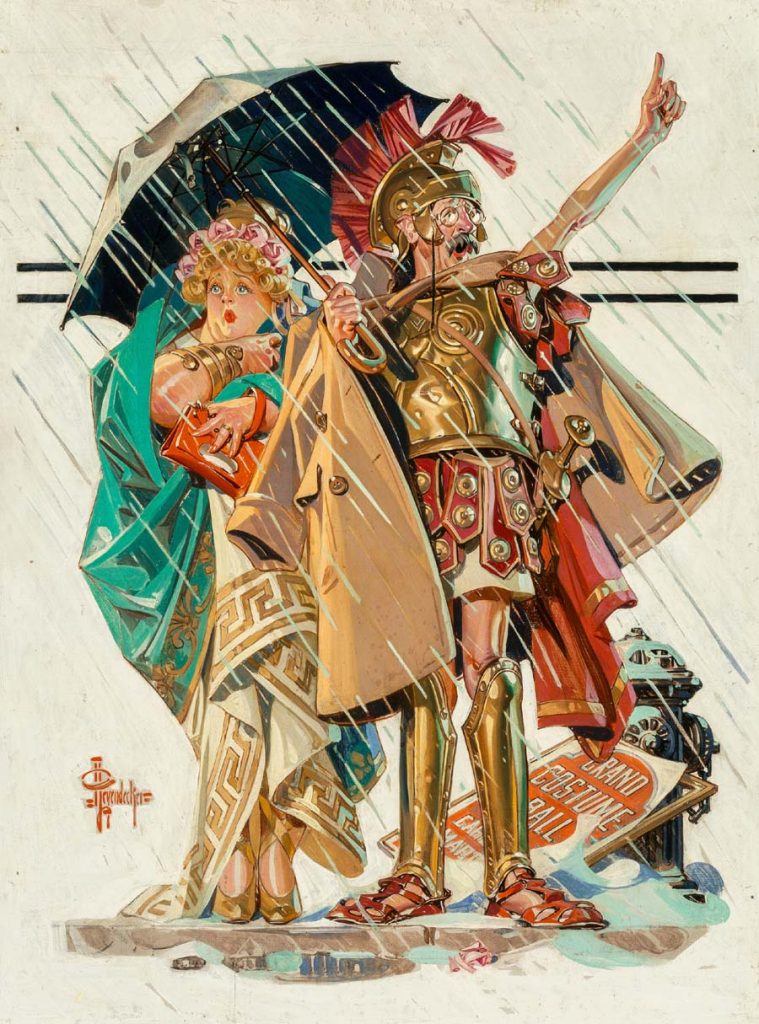A look Into the Real Life Great Gatsby.

Humble Beginnings
The Leyendecker Family was artistically inclined one way or another, J.C. Leyendecker was no exception from that fact. From the age of eight, Leyendecker would spend all day at school drawing in the margins of his papers and filling textbooks up with what he described as crude drawings. When he returned home he would oil paint on old kitchen rags. Later in his career, he would be influential to America’s Golden Age of Illustration, creating America’s first sex symbol, and inspiring F. Scotts Fitzgerald’s best-selling classic novel, The Great Gatsby.

Born in Germany, the family would immigrate over to America while Leyendecker was still young. They didn’t have much at first but luckily, J.C. Leyendecker would be allowed to study at the Art Institute of Chicago. In his family, his older brother Adolph would go into stained glass art, though he was never close with his family and was pretty much disowned after two very public scandals that tarnished his reputation beyond repair. This caused him to move away and be buried apart from his family. Though the rest of the Lydecker family would remain close. The two younger siblings would be very influential in supporting J.C. Leyendecker’s career working in the same studio and living with him. Frank and Augusta Leyendecker would both join J.C. at the Art Institute of Chicago.
After some time the Leyendecker family came to have more money and felt comfortable sending both J.C. and Frank away to Paris for classical education in painting. J.C. Leyendecker really enjoyed his time in Paris and often spent hours upon hours sketching and painting people in Paris Cafes. Frank was also an excellent illustrator but did not possess the same drive as J.C. and would often get lost in his brother’s shadow. Regardless of that fact, upon returning home the two Lydecker brothers would move to New York and open up an extremely successful studio with their sister Augusta.

This new studio is where J.C Leyendecker would rise in popularity for his commercial magazine illustrations. He would create over 322 covers for the Saturday evening post alone. Leyendecker’s other notable series would be posters for Collier’s automobiles and advertising WW2 bonds. His favorite advertisement series would be the Kelloggs Kids. These were illustrations of children with the ceral in magazines. Leyendecker loved painting and working with children as they were more expressive and dynamic in ways adults weren’t.

Leyendecker’s style in his work was notable for many reasons. His use of color, exaggerating proportions and dynamic figures helped to sell ideas for his commercial work. Leyendecker was known for painting these idealized figures of playful happy children, elegant well dressed women, and larger-than-life stoic athletic men to sell a product or idea. He was able to communicate a lot of character within subtle changes to expression and stylized proportion. I really appreciate his ability to tell stories in his work through the smallest of details. Everything he did was to communicate a narrative through his work
When creating an illustration it was clear that Lydecker was a draftsman at heart. Before setting out to paint his final illustration, he made several rough drafts, rehearsing the brushwork of every element until he got it just right. Everything he did was quite intentional in his sketches that he would later use gride method to blow up the painting on a larger scale.

Leyendecker’s most notable contribution in his work would be the Arrow Collar Man. This was America’s first sex symbol and was an extremely influential advertising series to sell the arrow collar in shirts. The Arrow Collar Man was never really the same face being depicted, just a consistently well-dressed stoic man, typical of Leyendecker’s work. This advertising series made the company extremely wealthy. The Arrow Collar factories got more love letters sent to their offices from women who saw Leyendecker’s illustrations and hoped to marry the man in the paintings, than the real and very famous young Louis Vuitton at the time.

Extravagant Endeavours
The Arrow Collar Man in the paintings was actually a real person. His name was Charles Beach, a live model who worked for Leyendecker and was extremely good-looking. From the day J.C. Leyendecker and Charles Beach met they would become inseparable. Beach would move in with Leyendecker and share an apartment. From there the two would go on to live with J.C.’s younger siblings Frankie and Agusta Leyendecker in J.C.’s famous large mansion.
Charles Beach fit in well with the other Leyendecker children and their business practices. Charles worked as J.C. Leyendecker’s model and would take up secretary roles in the studio. Agusta Leyendecker took on a matriarchal role in the house as well as working as the two brother’s managers. Frankie Leyendecker took on illustration jobs that J.C. Leyendecker didn’t have time for or couldn’t finish.

Charles, as well as being extremely good-looking was great at talking. He recommended they throw large parties under the guise of networking. This plan ended up working extremely well, Charles Beach’s amazing social skills made up for J.C Lydecker’s utter lack of sociability and they raised Lyndeckers sales immensely.
Illustrators were seen as celebrities, and Leyendecker was the most famous of them all. These extravagant parties attracted the attention of all the rich and famous to attend. Anyone who was anyone would go to Leyendecker’s larger-than-life events. In fact, they were so infamous, the novel ‘The Great Gatsby’ is actually based on Leyendeker and these extravagant parties. F. Scotts Fitsgerald, the writer of The Great Gatsby himself actually attended quite a few of these parties. This is also why literary enthusiasts believe The Great Gatsby to queer a coded novel among other reasons.

The Lost legacy
J.C Leyendecker was a gay illustrator in a time where is was dangerous to have been out or outed. His and Charles Beach’s relationship had always been more than platonic and they would live together in that mansion for the rest of their lives. Though, because of this fact, even with the extravagant parties, the two lived a very private life. J.C Leyendecker only took two interviews in his life and Charles Beach even less. This worried Leyendecker as he got older about his legacy since he worked so hard to keep himself personally out of the spotlight. Leyendecker wondered if all that effort would cause him to be forgotten. Which, unfortunately, he was right to be worried, he was nearly forgotten about in history and doesn’t get the proper respect for all he’s done with his influential body of work. Norman Rockwell, a student of J.C Leyendecker and close with the family would give what we know now as a very biased re-telling of J.C Leyendecker’s life. Though, he had great respect for Leyendecker and has kept his legacy somewhat alive in a way. That alone would be some of the only writings on J.C. Leyendecker still around. Before Leyendecker died he asked Charles Beach to take all his writings, letters, sketches, paintings, and unfinished or unpublished pieces and to burn them. Even after his death Leyendecker wanted to protect the name and careers of his friends and family and couldn’t leave anything that could have been seen as incriminating evidence of his homosexuality.
Even though most of his legacy will be lost to history, there are still pieces of his influence felt today. J.C Leyendecker defined classic American culture and paved the way for artists during America’s golden age of Illustration. There are echoes of him found in The Great Gatsby the novel’s movie adaptations. Yet, I believe J.C Leyendecker would have greatly appreciated that his home has turned into a school to teach young children how to paint, mixing his love for art and children into a lasting legacy.

Citations:
“J. C. Leyendecker.” Wikipedia, Wikimedia Foundation, 15 Sept. 2021, https://en.wikipedia.org/wiki/J._C._Leyendecker.
“J.C. Leyendecker.” Haggin Museum, https://hagginmuseum.org/leyendecker-j-c/.
“Joseph Christian Leyendecker : Shades of Colors and Lines.” Bartleby, https://www.bartleby.com/essay/Joseph-Christian-Leyendecker-Shades-Of-Colors-And-FKCUS3VQWQWF.
“Joseph Christian Leyendecker.” Artnet.com, http://www.artnet.com/artists/joseph-christian-leyendecker/.
“Joseph Christian Leyendecker.” The Illustrated Gallery, https://www.illustratedgallery.com/artwork/for-sale/artist/joseph-christian-leyendecker/.
Rowe, Kaz. “JC Leyendecker- The Iconic Gay Artist We ALMOST ForgotJC Leyendecker- the Iconic Gay Artist We … – Youtube.com.” Youtube, TouTube, 21 Mar. 2021, https://www.youtube.com/watch?v=BS7ayV2Ac74.
Image Citations:
“American Advertisement, Arrow Shirt Collars by Joseph Christian Leyendecker.” Fine Art America, https://fineartamerica.com/featured/american-advertisement-arrow-shirt-collars-joseph-christian-leyendecker.html.
Born: March 23, 1874 | Died: July 25. “J.C. Leyendecker.” Illustration History, https://www.illustrationhistory.org/artists/jc-leyendecker.
“J. C. Leyendecker.” Wikiwand, https://www.wikiwand.com/en/J._C._Leyendecker.
“Joseph Christian Leyendecker.” Artnet.com, http://www.artnet.com/artists/joseph-christian-leyendecker/.
Outmagazine. “Rediscovering J.C. Leyendecker & the Creation of the Perfect American Male.” OUT, Out Magazine, 6 Feb. 2015, https://www.out.com/entertainment/art-books/2012/09/04/jc-leyendecker-perfect-american-male-charles-beach.
Tangcay, Jazz. “Director Ryan White on Telling J.C Leyendecker’s Queer History in ‘Coded’.” Variety, Variety, 30 June 2021, https://variety.com/2021/film/markets-festivals/ryan-white-j-c-leyendecker-coded-1234998399/.
Taylor, Jeff. “J.C. Leyendecker: Norman Rockwell, but First and Make It Gay.” LOGO News, 23 Oct. 2019, http://www.newnownext.com/jc-leyendecker-illustrator-gay-lgbtq-history/10/2019/.